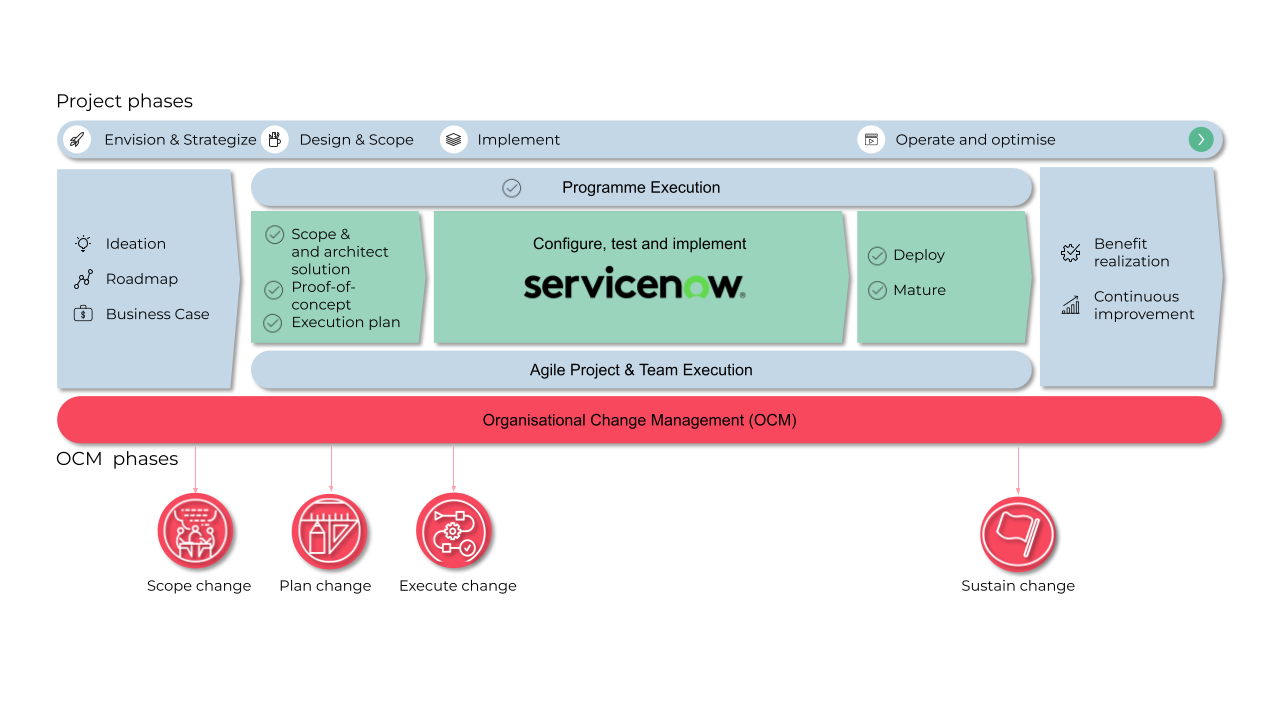ServiceNow is an excellent tool to streamline processes and increase efficiency in the organisation. The overall productivity can be further enhanced through Organisational Change Management (OCM) by accelerating the implementation and adoption of the system, thus improving Return of Investment (ROI).
ServiceNow is the clear leader in Service Management Tools, according to the Gartner Magic Quadrant 2021. The cloud-based platform optimises work processes and uses automation to eliminate paperwork and manual processes, thus increasing efficiency and satisfying internal and external customers. In our experience, ServiceNow can generate even more value with the proper focus on implementation.
ServiceNow comes with a range of tools and mechanisms designed for new users, such as guided tours, best practices and training sessions on the ServiceNow Platform. This is genuinely an implementation benefit. However, experience shows that this is rarely sufficient. The organisation needs to facilitate a change in employee behaviour to accept and appreciate the change and thus take full advantage of the system’s capabilities.
How can OCM drive and optimise the ROI?
The mindset behind OCM in this context is that change, such as implementing and utilising a new IT system, requires individual action and decisions. To humans, change is not natural, and change does not happen by chance or by itself. It’s a process that needs facilitation and guidance. This is supported by elaborate research and is the cornerstone of the international best practice ADKAR method used in ServiceNow projects.
The business case that drives the project can typically be based on unrealistic pre-conditions. For instance, the users being on board faster than realistic, all the users coming on board for the change, and finally, all users being equally proficient in the new solution. However, this will typically not be the case in reality, and as a result, ROI will arrive later and be smaller than expected.
To get the full benefit of ServiceNow, you have to work systematically with the people’s side of change from the initial planning to design and implementation and furthermore keep the focus on maturing the solution and sustaining the change. This OCM approach is illustrated in figure 1 below.

Integrate OCM in every step of the ServiceNow implementation
In our experience, the best way to implement ServiceNow is based on agile principles for an efficient timeboxed approach with maximum learning, involvement, and collaboration in multidisciplinary teams. This is combined with integrated OCM activities in every step for project management and OCM to go hand-in-hand and support each other for ServiceNow’s most efficient and effective implementation.
In the following, we will share some key activities and learnings regarding OCM in ServiceNow implementations.
Phase 1: Scoping OCM
Embed the change management into the business case for a realistic estimation. What is the size of the change effort? Is it large and complex, or is it smaller? When can you expect the benefits to arrive, and what do you have to do to make this happen. Phase 1 also includes a definition of the outcome the change should bring and how to measure it.
Specifically:
- We assess the scope and the organisation’s readiness based on best practices of digital surveys, interviews or workshops.
- On that basis, we determine the specific change ambition and effort.
Phase 2: Planning OCM
Communication, learning, and leadership activities should be performed before, during and after the implementation of ServiceNow for efficient use of people’s time and maximum effect.
Specifically:
- We develop an OCM communication plan, including messages, channels, senders,
recipients, and timing. - We establish a blueprint describing the future situation to communicate the ambition
and direction to the project’s stakeholders. - For end-user learning, we outline a learning journey based on the 70-20-10 best
practice principle (70% of learning is obtained from job-related experiences, 20%
from interactions with others and 10% from formal educational events). - We outline a project plan that describes the division of labour between the project
management and OCM for efficient execution.
Phase 3: Executing OCM
The execution emphasises involvement, dialogue, and communication. Our maxim is never to underestimate how often a message must be communicated before it is understood and accepted. According to best practice, the average is 5-7 times.
Specifically:
- We involve employees, leaders, and other stakeholders in dialogues, exchanges of
information, and learning exercises. - Create desire through “what’s in it for me” communication.
- Leaders, ambassadors, and change agents are briefed on their specific roles and
expected contributions. They must actively engage in the activities and be visible
throughout the project. - Communicate and never underestimate the need for this. We strive to be creative and use different
types of content and channels.
Phase 4: Sustaining the change
The change is not sustained by default but requires specifically designed processes, responsibilities, and communication. Key elements are firm governance, monitoring of the change happening and fulfilling the project’s outcome, KPIs, and continuous motivation. This phase is long in duration and integrated with operations.
Specifically:
- We provide a data-driven follow up on benefit realisation.
- We establish a continuous improvement set-up integrated with operations, preferably
in a Lean / Agile mode that involves key people sustaining the change. - Continued communication and motivation activities to reinforce and improve the
change and new behaviour.
The OCM effort can be supported by ServiceNow Impact for a personalised and data-driven acceleration of ROI.
If you want to hear more about OCM applied in ServiceNow projects and how this can boost ROI, please attend our webinar on September 28th, 14:00 CET. Partner – May-Britt Højgaard and Sales Director – Casper Grewal will share valuable learnings from ServiceNow projects, and Adam Haylock from ServiceNow will give practical advice on how the Impact module can accelerate ROI and support sustainable change. Register here.
